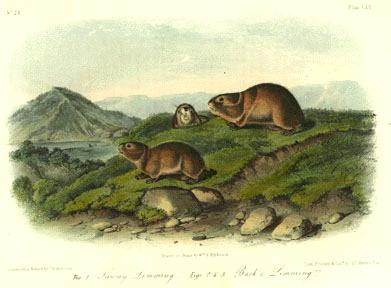

120 Tawny Lemming - Back's Lemming
GEORYCHUS HELVOLUS.--RICH.
[Synaptomys barealis]
TAWNY LEMMING.
[Northern Bog Lemming]
PLATE CXX.--FIG. 1.
G. Pollice instructus, naso obtuso albido, capite fulvo nigroque vario,
corpore supra fulvo, infra pallidiore, magnitudine G. Norvegici.
CHARACTERS.
Size of the Lapland Lemming; nose, blunt and light coloured; head, tawny
black; body, reddish-orange above, paler beneath; feet, furnished with thumbs.
SYNONYMES.
ARVICOLA (LEMMUS) HELVOLUS. Richardson, Zool. Jour., No. 12, p. 517, 1828.
ARVICOLA (GEORYCHUS?) HELVOLUS. Rich., Fauna Boreali Americana, p. 128.
DESCRIPTION.
Body, stout; head, oval; nose, short, blunt, and nearly on a line with the
incisors; eyes, small; ears, broad and not long--shorter than the fur, and
clothed with hair near the edges; tail, very short, clothed with stiff hairs,
which are longest near the extremity, and converge to a point; claws of both
extremities much alike, greatly compressed, and sharp pointed; the claws have an
oblong narrow groove underneath.
The thumbs on the fore feet consist almost entirely of a thick, flat,
squarish nail, resembling that of the Norway Lemming, and have, as in that
species, an obliquely truncated summit; in the Tawny Lemming, however, this
summit presents two obscure points.
The fur on the body is about nine lines long; that on the nose and
extremities, very short.
COLOUR.
Body, reddish-orange, interspersed on the back and sides with a number of
hairs longer than the fur, which are tipped with black; on the upper parts of
the head, around the eyes, and on the nape of the neck, the black hairs are more
numerous, and the colour of those parts is mingled black and orange. Nose,
grayish-brown; sides of the face, pale orange; margins of the upper lip, white;
tail, coloured like the body; feet, brownish.
DIMENSIONS.
Inches. Lines.
Length of head and body, . . . . 4 6
Length of tail, . . . . . . . 0 7
Length of head, . . . . . . . 1 6
Hind feet to end of claw, . . . . 0 8
Forefeet and claws, . . . . . . 0 4 1/2
HABITS.
Mr. DRUMMOND, who obtained this animal, procured no further information in
regard to its habits than that it was found in Alpine swamps. It bears a strong
resemblance to the Norway Lemming, and we may presume does not differ widely
from that species in its habits, which it is said are migratory to a surprising
extent, and about which some curious stories are related that we do not consider
necessary to place in our work.
This Lemming is one of those animals we have never seen except the stuffed
specimens. Our figure was drawn in London by J. W. AUDUBON from the original
skin procured by Mr. DRUMMOND.
GEOGRAPHICAL DISTRIBUTION.
This animal was found in lat. 56 degrees, in mountainous yet moist places,
in the northwest. We have not heard of its existence in any other locality, but
have no doubt it has a pretty extensive northern range.
GENERAL REMARKS.
The Lemmings have been arranged by authors, CUVIER, ILLIGER, and others,
under a distinct subgenus--Georychus.
They are characterized chiefly by the shortness of the ears and tail, and
large strong claws, remarkably well fitted for digging; this subgenus, however,
so nearly approaches the Arvicolae in some of its species that it is difficult
to decide in which genus they should really be placed.
|